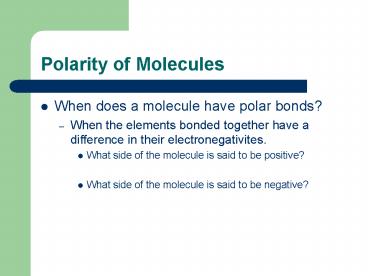Polarity of Molecules - PowerPoint PPT Presentation
1 / 11
Title:
Polarity of Molecules
Description:
Using an electric field ... Step 2: Determine what electron-group, then what molecular shape the molecule has ... The greater the number of electrons, the ... – PowerPoint PPT presentation
Number of Views:22
Avg rating:3.0/5.0
Title: Polarity of Molecules
1
Polarity of Molecules
- When does a molecule have polar bonds?
- When the elements bonded together have a
difference in their electronegativites. - What side of the molecule is said to be positive?
- What side of the molecule is said to be negative?
2
Using an electric field
- Can use an electric field to determine if the
molecules that you are looking at are polar or
nonpolar - Polar molecules will orient themselves to have
the polar end pointing towards the negative plate
and the negative end will point towards the
positive plate - Nonpolar molecules will not be affected by the
electric field
3
How to tell if a molecule is polar
- Step 1 Draw the Lewis Dot structure for the
molecule - Step 2 Determine what electron-group, then what
molecular shape the molecule has - Step 3 Identify where the positive and negative
ends are for each bond - Step 4 Draw in the arrows for the polarity and
see if the polar bonds cancel in the molecule
4
Can a molecule have polar bonds, but not be polar?
- Yes or No
- Lets look at C Cl
- This molecule has polar bonds, but because of the
geometry, it is not polar
5
London Dispersion
- Present between polar and nonpolar moelcules
- Picture
6
Why do you suppose that Cl2 is a gas, Br2 is a
liquid, and I2 is a solid?
- Cl has less electrons than Br, and Br has less
electrons than I - More electrons cause more electron shifting
greater LD forces - The greater the number of electrons, the greater
the LD force - As you increase the size of the atom, you
increase the LD force
7
Which member of each pair has the stronger LD
forces?
- Ne and Kr
- F2 and Cl2
- CH4 and SiCl4
- N2 and O2
- N2 has a boiling point of 77.4 K
- O2 has a boiling point of 90.2 K
- Larger BP means larger LD
8
Dipole-Dipole Forces
- Stronger than London Forces
- Definition The permanent dipoles of polar
molecules attract one another - Strength of these forces depend on the dipole
moment of the moelcules - So, the greater the difference in EN, the larger
the dipole moment, the strong the dipole-dipole
forces
9
Hydrogen-bonding
- The H bond is an especially strong dipole-dipole
force - Hydrogen can hydrogen bond with F, O, or N
- Conditions for occurrence
- H must be covalently bonded to a small, highly
electronegative element in one molecule - The H is then positively charged, so it is
attracted to the negative end of another molecule
10
What types of intermolecular forces are observed
in each of the following?
- H2O HF
- HBr NH3
- PF3 CH3OH
- F2 N2
- CO2
11
Hydrogen-bonding
- H-bonding is critical for life
- Used in the structure of DNA
- Stabilizes the shapes of proteins and nucleic
acids, protecting their biological roles































